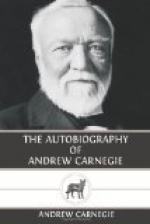In like manner the demand for locomotives was very great, and with Mr. Thomas N. Miller[24] I organized in 1866 the Pittsburgh Locomotive Works, which has been a prosperous and creditable concern—locomotives made there having obtained an enviable reputation throughout the United States. It sounds like a fairy tale to-day to record that in 1906 the one-hundred-dollar shares of this company sold for three thousand dollars—that is, thirty dollars for one. Large annual dividends had been paid regularly and the company had been very successful—sufficient proof of the policy: “Make nothing but the very best.” We never did.
[Footnote 24: Mr. Carnegie had previous to this—as early as 1861—been associated with Mr. Miller in the Sun City Forge Company, doing a small iron business.]
When at Altoona I had seen in the Pennsylvania Railroad Company’s works the first small bridge built of iron. It proved a success. I saw that it would never do to depend further upon wooden bridges for permanent railway structures. An important bridge on the Pennsylvania Railroad had recently burned and the traffic had been obstructed for eight days. Iron was the thing. I proposed to H.J. Linville, who had designed the iron bridge, and to John L. Piper and his partner, Mr. Schiffler, who had charge of bridges on the Pennsylvania line, that they should come to Pittsburgh and I would organize a company to build iron bridges. It was the first company of its kind. I asked my friend, Mr. Scott, of the Pennsylvania Railroad, to go with us in the venture, which he did. Each of us paid for a one fifth interest, or $1250. My share I borrowed from the bank. Looking back at it now the sum seemed very small, but “tall oaks from little acorns grow.”
In this way was organized in 1862 the firm of Piper and Schiffler which was merged into the Keystone Bridge Company in 1863—a name which I remember I was proud of having thought of as being most appropriate for a bridge-building concern in the State of Pennsylvania, the Keystone State. From this beginning iron bridges came generally into use in America, indeed, in the world at large so far as I know. My letters to iron manufacturers in Pittsburgh were sufficient to insure the new company credit. Small wooden shops were erected and several bridge structures were undertaken. Cast-iron was the principal material used, but so well were the bridges built that some made at that day and since strengthened for heavier traffic, still remain in use upon various lines.
The question of bridging the Ohio River at Steubenville came up, and we were asked whether we would undertake to build a railway bridge with a span of three hundred feet over the channel. It seems ridiculous at the present day to think of the serious doubts entertained about our ability to do this; but it must be remembered this was before the days of steel and almost before the use of wrought-iron in America. The top cords and supports were all of cast-iron. I urged my partners to try it anyhow, and we finally closed a contract, but I remember well when President Jewett[25] of the railway company visited the works and cast his eyes upon the piles of heavy cast-iron lying about, which were parts of the forthcoming bridge, that he turned to me and said:




